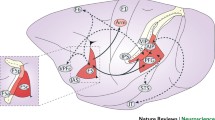Abstract
The discovery of mirror neurons has been hailed as one of the most exciting developments in neuroscience in the past few decades. These neurons discharge in response to the observation of others’ actions. But how are we to understand the function of these neurons? In this paper I defend the idea that mirror neurons are best conceived as components of a sensory system that has the function to perceive action. In short, mirror neurons are part of a hitherto unrecognized “sixth sense”. In this spirit, research should move toward developing a psychophysics of mirror neurons.
Similar content being viewed by others
References
Bach-y-Rita, P. (1996). Sensory substitution and qualia. In J. Proust (Ed.), Perception et Intermadalité (pp. 81–100). Paris: Presses Universitaires de France (Reprinted from Vision and mind: Selected readings in the philosophy of perception, pp. 497–514 by A. Noë, & E. Thompson, Eds. Cambridge: MIT Press).
Butts, D., & Goldman, M. (2006). Tuning curves, neuronal variability, and sensory coding. PLoS Biology, 4, e92.
Calvo-Merino B., Glaser D.E., Grezes J., Passingham R.E., Haggard P. (2005) Action observation and acquired motor skills: An fMRI study with expert dancers. Cerebral Cortex 15: 1243–1249
Cheng Y., Meltzoff A., Decety J. (2006) Motivation modulates the activity of the human mirror-neuron system?. Cerebral Cortex 17: 1979–1986
Coady C. (1974) The senses of martians. The Philosophical Review 83: 107–125
Dragoi V., Sharma J., Sur M. (2000) Adaptation-induced plasticity of orientation tuning in adult visual cortex. Neuron 28: 287–298
Ferrari P., Rozzi S., Fogassi L. (2005) Mirror neurons responding to observations of actions made with tools in monkey ventral premotor cortex. Journal of Cognitive Neuroscience 17: 212–226
Fogassi L., Ferrari P., Gesierich B., Rozzi S., Chersi F., (2005) Parietal lobe: From action organization to intention understanding. Science 308: 662–667
Gallese V. (2006) Intentional attunement: A neurophysiological perspective on social cognition and its disruption in autism. Brain Research 1079: 15–24
Gallese V., Fadiga L., Fogassi L., Rizzolatti G. (1996) Action recognition in the premotor cortex. Brain 11: 593–609
Gardner, E., & Martin, J. (2000). Coding of sensory information. In E. Kandel, J. Schwartz, & T. Jessell (Eds.), Principles of neural science (pp. 411–429). New York: McGraw-Hill.
Gertler B. (2001) Introspecting phenomenal states. Philosophy and Phenomenological Research 63: 305–328
Gibson J.J. (1966) The senses considered as perceptual systems. Waveland Press, Inc, Prospect Heights
Gibson J.J. (1979) The ecological approach to visual perception. Houghton-Mifflin, Boston
Gray R. (2005) On the concept of a sense. Synthese 147: 461–475
Grice, H. (1962). Some remarks about the senses. In R. J. Butler (Ed.), Analytical philosophy, Series 1 (pp. 133–153). Oxford: Blackwell (Reprinted from Vision and mind: Selected readings in the philosophy of perception, pp. 35–54 by A. Noë & E. Thompson, Eds. Cambridge: MIT Press).
Gur M., Kagan I., Snodderly D. (2005) Orientation and direction selectivity of neurons in V1 of alert monkeys: Functional relationships and laminar distributions. Cerebral Cortex 15: 1207–1221
Hamilton A., Grafton S. (2006) Goal representation in human anterior intraparietal sulcus. The Journal of Neuroscience 26: 1133–1137
Heil J. (1983) Perception and cognition. University of California Press, Berkeley
Iacoboni M. (2005) Neural mechanisms of imitation. Current Opinion in Neurobiology 15: 632–637
Iacoboni M., Dapretto M. (2006) The mirror neuron system and the consequences of its dysfunction. Nature 7: 942–951
Keeley B. (2002) Making sense of the senses: Individuating modalities in humans and other animals. The Journal of Philosophy 94: 5–28
Kohler E., Keysers C., Umilta M., Fogassi L., Gallese V., Rizzolatti G. (2002) Hearing sounds, understanding actions: Action representation in mirror neurons. Science 297: 846–848
Lyons D., Santos L., Keil F. (2006) Reflections of other minds: How primate social cognition can inform the function of mirror neurons. Current Opinion in Neurobiology 16: 230–234
Nelkin N. (1990) Categorising the senses. Mind and Language 5: 149–65
Noë A. (2004) Action in perception. MIT Press, Cambridge
Nudds M. (2004) The significance of the senses. Proceedings of the Aristotelian Society 102: 31–51
O’Regan J., Noë A. (2001) A sensorimotor account of vision and visual consciousness. Behavioral and Brain Sciences 24: 939–1031
Rizzolatti G., Craighero L. (2004) The mirror-neuron system. Annual Review of Neuroscience 27: 169–192
Rizzolatti G., Fogassi L., Gallese V. (2001) Neurophysiological mechanisms underlying the understanding and imitation of action. Nature Neuroscience Reviews 2: 661–670
Roxbee-Cox J. (1970) Distinguishing the senses. Mind 79: 530–550
Umilta M., Kohler E., Gallese V., Fogassi L., Fadiga L., Keysers C. (2001) I know what you are doing: A neurophysiological study. Neuron 31: 155–165
Author information
Authors and Affiliations
Corresponding author
Additional information
This paper has evolved quite a bit since I first presented it to a Metaphysics of Science Workshop in October 2007. Present to offer me very useful advice were Ken Aizawa, Carl Gillett, Tom Polger, Bob Richardson, and Jackie Sullivan. I’m also grateful to the audience that heard me deliver this paper at University of Cincinnati in November 2007, as well as an audience at the University of Wollongong in June 2008.
Rights and permissions
About this article
Cite this article
Shapiro, L. Making sense of mirror neurons. Synthese 167, 439–456 (2009). https://doi.org/10.1007/s11229-008-9385-8
Received:
Revised:
Accepted:
Published:
Issue Date:
DOI: https://doi.org/10.1007/s11229-008-9385-8




